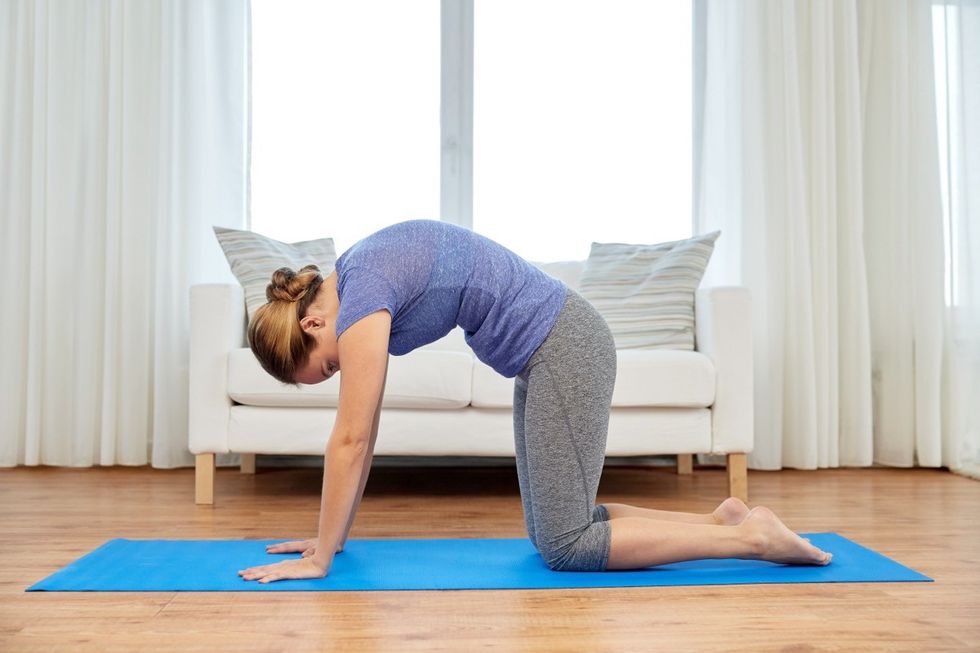One arguably underrated aspect of overall wellness is flexibility. While you don’t necessarily need to be able to touch your toes to be in good shape, you may not realize how integral your body’s range of mobility is. In fact, according to Zach Clayton, a professional wrestler and fitness expert behind Prestige Health Systems, flexibility helps prevent injury, enhance your athletic performance, and keep you doing your daily activity “with ease.” In addition, flexibility exercises can help you achieve your fitness goals that much faster.
“Flexibility is as important as strength. It’s great to be strong and have a six-pack, but if you can’t look behind you or pick up your keys when you drop them, then all that strength and muscle mass doesn’t help much,” Dalton Grant, yoga instructor and founder of The Light Orchard, tells Best Life. “Flexibility is also important for improving your strength. The more a muscle can expand, the stronger it can become. Motion is medicine.”
While you probably understand that stretching is the best thing to improve your flexibility, if you’re not particularly limber, sitting down to do so can be a daunting task. (I speak from experience.) So, to ensure you get the most out of your stretching routine, we consulted fitness experts for their thoughts on the five best exercises for flexibility. Read on to find out what they recommend.
RELATED: The 5 Best Stretches That Will Warm You Up for Any Workout.
1 | Cat-cow stretch
Shutterstock
The most commonly recommended stretch for flexibility was the basic cat-cow stretch, which stretches your spine, shoulders, and neck.
“This is a great dynamic stretch that mobilizes the spine. The movement helps relieve tension in the back while improving flexibility in the shoulders and neck,” Stacy Orsborn, certified personal trainer and co-founder of VICTRESS MVMT, tells Best Life.
To do cat-cow, start on all fours and breathe in as you arch your back down and your neck upwards for cow pose. When you breathe out, round your back and look down to shift into cat pose.
2 | Low lunge
Shutterstock
Lunges aren’t always done with weights or during a high-intensity workout class—they’re also a great option when you’re slowing down and stretching.
Low lunge “is an everyday necessity for all of us. We all sit far too much, shortening our psoas muscle and not giving it the flexion and extension it needs to stay healthy,” Dalton says, adding that the pose, known as Anjaneyasana in Sanskrit, “gives the psoas muscle the big open stretch that it needs to stay pliable.”
To get into low lunge, kneel on one leg and place the other in front of you at a right angle, Clayton says. Then, lunge forward while keeping your back straight. Alternate your legs and notice the stretch in your groin muscles.
3 | Chest-opening stretch
Shutterstock
You also want to stretch your upper body, so introducing a chest opener is key to improve range of motion and posture.
Bonnie Strati, master trainer at StretchLab and certified yoga instructor, recommends accomplishing this by clasping your hands behind your back and lightly pulling.
You can also stretch your chest using the doorways in your home, per a suggestion from Alexandra Ellis, mobility coach and wellness expert at AE Wellness LLC.
“My favorite way to improve upper body flexibility is to touch the top of a doorway in my house. Pick one, and remind yourself to reach up every time you walk under it,” she recommends.
Ellis adds, “Incorporating something simple like touching the top of the doorway will help you to get more movement into your shoulders and improve shoulder flexibility at the same time.”
RELATED: This Simple Form of Exercise Could Help You Live Longer, New Study Shows.
4 | Figure 4 stretch
Shutterstock
To stretch your hips and your glutes, try a figure 4 stretch.
“This is a fantastic stretch to loosen up the hips and glutes, which can get tight from sitting or after lower body workouts,” Orsborn says. “It’s especially helpful for runners or anyone experiencing hip discomfort.”
Strati also recommends the figure 4 stretch to reduce lower back tightness. To do it, cross your ankle over your knee in a seated position or on your back. While on you’re back, you can gently pull the lower leg towards you and feel the stretch in the glute muscles of your crossed leg.
5 | Forward fold
Shutterstock
If you notice your hamstrings are often tight, you might want to introduce more forward-fold stretches into your routine. This can be done standing, using gravity to pull you down and “decompress the lower spine,” per Orsborn. And while standing options are great if you sit during the day at a desk, you can also do this stretch sitting down and reaching for your toes. (Don’t force this one! Just reach as far as you can comfortably.)
You can also try Clayton’s option of crossing your legs over one another while standing to focus on one leg at a time.





